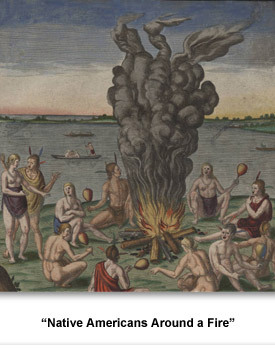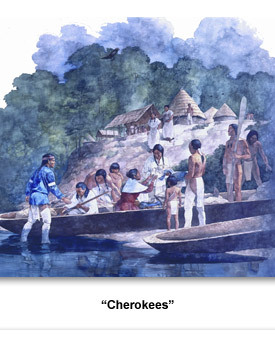Indians & Cultural Encounters
Indians & Cultural Encounters
Early American Indians (sometimes called Historic Indians ) lived across what is now Tennessee when European explorers arrived. In some cases, contact between the Europeans and Indians was peaceful. At other times, it was not.
More and more Europeans began exploring the continent. Because of this, Indians, including those in Tennessee, would find their lives drastically changed.
Native Americans and Europeans had different cultures. They had different types of family, different styles of dress, and different religions. Jobs done by men and women in each culture differed somewhat. Indians also had unique art, music, and dance styles.
European contact changed many Indian practices. For example, their style of dress became more European. Indians also used more European tools in their day-to-day life. They also began using European goods in their art.
Europeans thought that the Indian tribes had no government. This was wrong. Indians had complex governments. Political disagreements, especially disagreements over how to deal with Europeans, led to conflict and division.
The British and the French had a great deal of influence over Indians through trade. However, Indians also had influence over the British and the French. They were often able to play the European nations against one another for their own benefit. This changed drastically after the French and Indian War.
Acknowledgements
Acknowledgements
Teacher's Page
Picture Credits:
- Painting entitled “Cherokees” circa 1760. Life size mural by Greg Harlin. This contemporary painting represents how the artist thought a typical village scene might have looked. It is based upon archeological research and depicts a village at one of the settlements along the lower Little Tennessee River. European and American trade goods are also shown and would have been transported and exchanged in centers such as this. Courtesy of the Frank H. McClung Museum, The University of Tennessee.
- Print entitled, “Native Americans Around a Fire.” This picture depicts a group of Indians sitting around a fire with a coastal scene in the background. Originally drawn by John Whyte this picture was originally included in the book A Briefe and True Report of the New Found Land of Virginia by Thomas Hariot. Later the image was engraved by Theodor de Bry and reprinted in 1590. De Bry wanted to make Native Americans look more like Europeans, so he drew them with blonde hair and white skin. Although the drawing is not entirely accurate, it demonstrates how some Europeans did not understand or appreciate the ways in which Native Americans were different from them.The group pictured belongs to the Southern Algonquian group of Indians who are related to the Shawnee. North Carolina Collection, University of North Carolina.
Acknowledgments:
Any views, findings, conclusions, or recommendations expressed in this web site do not necessarily reflect those of the National Endowment for the Humanities.
Indians & Cultural Encounters >>


 Sponsored by: National Endowment for the Humanities
Sponsored by: National Endowment for the Humanities